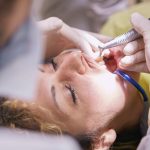
You might have heard about periodontal treatment during a visit to your dentist or caught the term online while researching dental health topics. If you’re wondering what it’s all about and if it’s something you might need, you’re in the right place.
Periodontal disease is a set of inflammatory conditions that affect the tissues surrounding the teeth, which can range from gingivitis to more severe periodontitis.
What Is Periodontal Treatment?
Catching a periodontal disease early is crucial, and that’s where comprehensive periodontal care comes into play. It involves a detailed evaluation of your gums and supporting structures, identifying early signs of disease so they can be addressed promptly. If your gums bleed when you brush your teeth or if you notice persistent bad breath, it’s time to talk to your dentist about comprehensive periodontal care.
Periodontal treatment is not one-size-fits-all. It includes various procedures tailored to the specifics of the patient’s condition.
Non-Surgical Approaches
-
Scaling and Root Planing: A deep cleaning process that removes tartar and plaque from below the gum line
-
Antibiotic Treatment: Using medicines to fight infection and promote healing
Surgical Interventions
For advanced cases, surgery might be necessary, like flap surgery or bone and tissue grafts, to restore damaged areas.
Who Needs Periodontal Treatment?
Now that we’ve touched on the disease let’s discuss who’s at risk and who actually needs periodontal treatment. It may be broader.
1. Individuals with Signs of Gum Inflammation or Bleeding
Persistent gum inflammation, redness, swelling, or bleeding during brushing or flossing may indicate gum disease and warrant periodontal treatment. Early intervention can prevent the progression of gum disease and preserve oral health.
2. People with a Family History of Tooth Loss
Individuals with a family history of tooth loss or a genetic predisposition to gum disease may be at increased risk. They may benefit from preventive periodontal treatment to maintain healthy gums and teeth.
3. Those with Chronic Conditions such as Diabetes
Chronic health conditions such as diabetes can compromise the body’s ability to fight infections, including gum disease. Individuals with diabetes are at higher risk of developing gum disease and may require periodontal treatment to manage gum health and prevent complications.
4. Smokers and Tobacco Users
Smoking and tobacco use are significant risk factors for gum disease, as they impair blood flow to the gums and weaken the body’s immune response. Smokers and tobacco users are more prone to gum inflammation, periodontal disease, and tooth loss and may require periodontal treatment to address these issues.
5. Patients with Crooked Teeth that are Hard to Clean
Misaligned or crooked teeth can create areas where plaque and tartar buildup are difficult to remove through regular brushing and flossing. These areas become prone to gum disease and may require periodontal treatment to address inflammation and restore gum health.
6. Individuals with Poor Oral Hygiene Habits
Poor oral hygiene practices, including inadequate brushing, flossing, and regular dental check-ups, can increase the risk of gum disease. Individuals with poor oral hygiene habits may benefit from periodontal treatment to remove plaque and tartar buildup, reduce inflammation, and improve gum health.
Maintaining Good Oral Health After Treatment
After periodontal treatment, your journey to maintaining a healthy mouth continues. Here are some tips to ensure lasting results:
-
Stick to a Routine of Brushing and Flossing: Brush your teeth at least twice a day with fluoride toothpaste and floss daily to remove plaque and bacteria from between your teeth and along the gumline. Proper oral hygiene helps prevent the buildup of plaque and tartar, reducing the risk of gum disease.
-
Use an Antibacterial Mouthwash Recommended by Your Dentist: Your dentist may recommend an antibacterial mouthwash to help reduce plaque and bacteria in your mouth. Use the mouthwash as directed to complement your brushing and flossing routine and maintain a healthy oral environment.
-
Maintain a Balanced Diet and Reduce Sugar Intake: A balanced diet rich in fruits, vegetables, lean proteins, and whole grains supports overall oral health. Limit sugary and starchy foods, as they can contribute to plaque formation and increase the risk of gum disease and tooth decay.
-
Quit Smoking and Tobacco Use for Good: Smoking and tobacco use are major risk factors for gum disease and can impair the healing process after periodontal treatment. Quitting smoking and avoiding tobacco products can significantly improve your oral health and reduce the risk of gum disease recurrence.
-
Attend Frequent Dental Check-ups to Monitor Your Condition: Regular dental check-ups are essential for monitoring your oral health and detecting any signs of gum disease recurrence or other dental issues early. Your dentist can provide professional cleanings, evaluate your gum health, and recommend additional treatments or preventive measures as needed to maintain optimal oral health.
-
Professional teeth cleaning: This is designed to remove plaque and bacteria that you might miss during regular brushing and flossing. Special tools are used to gently remove deposits without harming your teeth.
Taking these actions can help keep periodontal disease at bay and ensure your smile stays bright and healthy.
Final Thoughts
Empowering yourself with the knowledge of periodontal treatment and the importance of teeth cleaning is a giant leap toward better dental health. By catching issues early and adhering to your dentist’s guidance, you can enjoy the benefits of a healthy mouth for years to come. Stay attentive, stay proactive, and let your smile reflect your commitment to your oral health.




















































